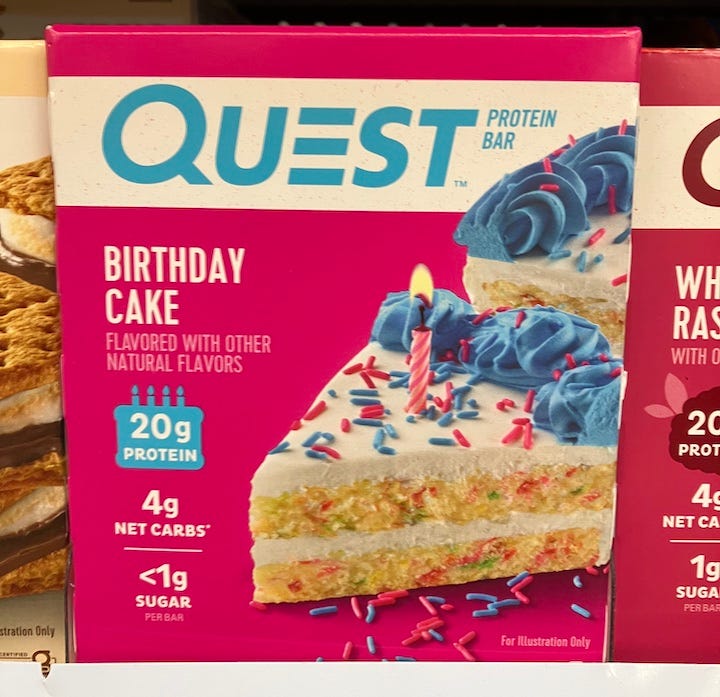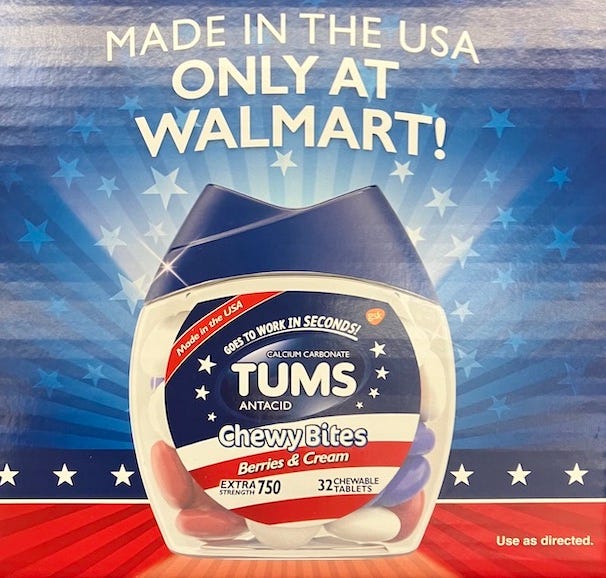We went to the river the other day. It’s a big river and we brought lots of chips. Salty snacks next to water on a summer afternoon: this is a basic human joy, shared by Americans and Kiwis and any human on the planet. In NZ the classic flavor is salt & vinegar. America is too big and messy for a single winner, and we feel forever entitled to something new. In America we take it to Flavortown.
On this particular afternoon our ticket to Flavortown was a bag of Clancy’s Fried Pickle Ranch Flavored Wavy Potato Chips. I was intrigued. In real life, as it were, fried pickles are delicious. They were invented, as the story goes, by Bernell “Fatman” Austin in Atkins, Arkansas in 1963: tart dill pickles, deep-fried in spears or slices and served with a dipping tub of ranch dressing. I feel like they’ve fallen from favor a bit, at least outside their native South? (CORRECTION: They’re everywhere, thanks for the comments!) I first tasted them as a boy in a dim cowboy steakhouse in La Veta, Colorado. The steakhouse is decades gone. I’ve been out of the country and this bag of chips was my first taste in years. But a taste of what, exactly? They were…fine? I stared at the photo on the bag and wished for the real thing.
America can feel like this sometimes: awash in nostalgic images of itself, satisfying as long as you’re between real meals. There are proud flags everywhere here in Sioux City IA, and yet all week we’ve been getting an alert on our phones telling us the 911 service is down. If you’re in an emergency, it says, call this random South Dakota number instead.
Big theory swing now: Walter Benjamin saw it all coming. From “The Work of Art in the Age of Mechanical Reproduction,” written the gloomy days of 1935: “Every day the urge grows stronger to get hold of an object at very close range by way of its likeness, its reproduction.” Seventy-odd years before smartphones, this was.
Benjamin was worrying about what photography and film did to art and plays. In reproduction, he tells us, we lose the “aura” granted to the original art by the limits of time, space, and history. For art, it’s the limits of a singular handmade object; for a play, it’s actors facing an audience across the same room.
Now let’s do bar food. Fried Pickles, the actual dish, are limited by geography (not likely on menus in Vermont), convenience (tricky to make without a restaurant fryer), the physical performance of eating them (fried dill pickle in your hand, cup of ranch in the basket) and that crucial temperature combo (fryer-hot dipped into fridge-cold). Their reproduction as a chip flavor sheds all of this in the name of wide dissemination and sales. Benjamin’s example is Faust on stage versus Faust on film, but it holds up here: the crappiest truckstop fried pickles, or the burnt mass sticking to your own frying pan, contain more aura than a fleet of trucks delivering a million bags of chips across a continent of grocery store shelves.

All good so far. The culinary explosion here over the last few decades, driven by a joyous mix of immigration, new interests in health and the environment, and the pride of rediscovered tradition, has generated aura by the food-truck load. Even good ol’ Sioux City IA has a farmers market now, an Eritrean restaurant, and tacos as legit as anywhere the Southwest.1
But in America, alas, the trucks are always one mile ahead. The grocery store’s aura-free reproductions have expanded at a breakneck pace. I’m not talking about the orange ‘cheese’ on Cheetos, or that purple-candy tang we’ve long learned to accept as ‘grape.’ These are the wide-eyed innocents now, Flavortown’s black-and-white TVs. I’m talking about the ever more baroque and abstract flavors designed to summarize entire real-world experiences, applied to any consumer product that can carry them.
We’ve got Birthday Cake vodka and Birthday Cake protein bars. We’ve got Mexican Street Corn chips and Mexican Street Corn dips. Pumpkin Spice as an annual national holiday. Lay’s Potato Chips recently dropped a special edition Everything Bagel with Cream Cheese flavor. At Walmart yesterday I spotted Chocolate Dipped Pistachio coffee pods. Why not just chocolate and pistachio? How do you make coffee taste like a verb? And it’s more than food, too. Since coming home I’ve washed my hands with soaps scented to evoke the physical non-smell sensations of actual places (Fiji White Sands, Honolulu Sun) and even the joy of a semi-sacred social ritual (Champagne Toast, wedding not included).
This, my friends, is the *real* Flavortown. Not Guy Fieri’s famous epithet, which the frosted-tip sage awards to actual Americans cooking perishable food in specific American towns. Flavortown is the simulacrum, the Keurig pod of a nation’s cultural life. It’s not Fried Dill Pickles and Ranch Dressing, it’s Fried Pickle Ranch, an appetizer shrunk to a sub-varietal of a fake salad dressing. Once upon a time ranch dressing was made of garlic, buttermilk or something cream, and parsley; you can make a tasty batch at home in five minutes. The packaged version rose to prominence under the brand Hidden Valley Ranch, a pastoral and all but explicitly white fantasy that smartly dropped the ‘dressing’ and settled on a name where condiment and the mythic American frontier home place are one and the same. The unattainability of the dream was the whole point: “Not everyone can live in Hidden Valley, but you sure can get a taste of it.” But maybe the copy is all we need. There’s a soda now. There’s ice cream.
But Benjamin’s worry was not, or not entirely, that copies would replace true art. This was 1935 in Europe: auras were good because they were “completely useless for the purposes of Fascism.” Mass reproduction makes the good show any dictator needs. “Fascism sees its salvation in giving these masses not their right, but instead a chance to express themselves,” he wrote. “The logical result of Fascism is the introduction of aesthetics into political life.”
We’ve been in Trumpworld for nine years now. We’ve forgotten how weird it is that a President of the United States is so closely identified with a damn hat. All that tactical gear, all those fairground t-shirts, the Arial-font flag snapping from the party boat on the river below us: all politics as an aesthetic.
An ugly adhoc, as aesthetics go?
, comparing Trump’s rise to Hitler, notes the latter did have a polished style—the logo, the banners, the Leni Riefenstahl flicks. But each nation paves its own path to hell. Benjamin, a German Jew fleeing the Nazis, could have written about the fascist aesthetics of racial purity; in his essay about technology, he rails instead against the Futurists, a bunch of stylish Italian artists who thought modern warfare looked really cool. In postwar New Zealand, the critic Bill Pearson worried his country might succumb to authoritarianism because his countrymen were too, well, sheeplike: “a docile sleepy electorate, veneration of war-heroes, willingness to persecute those who don't conform, gullibility in the face of headlines and radio peptalks.” In America, goes the apocryphal Sinclair Lewis quote, fascism will come “wrapped in the flag and carrying a cross.”The quote travels so widely because it makes political sense: in a fundamentally conservative country, the bad old ghosts seem more likely to appear stage right. But of course he’s talking about an aesthetic, a moodboard, a vibe. The novelist and ‘stacker
reports that the Nazis in his DMs now just sign off with the American flag emoji, shorthand for “fuck around and find out.”The flag’s the wrapper. Wrappers only sell if they’ve got a tasty abstraction inside. What is Make America Great Again but a photo of yummy fried pickles on a bag full of the dehydrated buttermilk of white resentment? How could you not haunt the thundering spectacle of the American grocery aisle and find yourself longing for a time when we actually cooked the flavors promised on each label? When we finished a meal with berries and cream, instead of Tums Chewy Bites Berries & Cream?
But I fear I’ve got it backwards. Flavortown conditions us not to pine for the false nostalgia of the flag and cross but to thirst for the chemical tang of Flag Cross Ranch. For us, the abstraction is the juice. When fascism comes to America, we’ll have been so primed by a lifetime of ever-tastier reproductions that we won’t be able to put down the bag.
I gotta go. Snacktime in Iowa. My kids are in their grandmother’s kitchen, happily scarfing bowls of their life’s first Goldfish Crackers. They like them fine.
Next time, my son says, his voice rising in the thrill of anticipation, I want to try the Flavor Blasted kind!
That makes a dozen letters here at NZ American! Thanks for signing up and sticking around. Welcome to the new subscribers sent here by the excellent
at Leah McFall’s Domestic Detail. Glad to have you with us! If y’all dig it, please share—









As someone who travels this country a lot, and always orders the fried pickles, I can attest that they are more common than ever. I've had them, in the just the last month or so, in Portland OR, Evanston IL, and Washington DC. What has changed, though, is where you used to get a basket of whole spears, now the pickle "chip" is ubiquitous. MAKE FRIED PICKLES SPEARS AGAIN
dehydrated buttermilk of white resentment. good lordy.